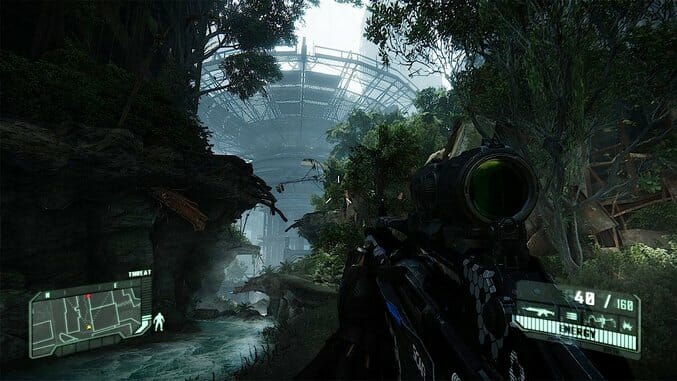Crysis 3 (Multi-Platform)

I was at a party a few years back and, as it usually goes, I was outed as a videogame critic by a well meaning friend. One of the other guests, who confessed that she didn’t play videogames, asked what I was working on and, at the time, it happened to be a review of Crysis 2. I explained how realistic it looks, how much time and effort went into crafting this simulation of New York, and I lamented that all you did was shoot people in the face. She didn’t quite understand my problem. Is not all this technology at the service of face shooting? Why would somebody expect a videogame to be anything more than that? Why view the game in any other context than the one that the medium’s artists have created?
Crysis 3 is a pretty okay shoot-people-in-the-face type of game, but it’s so annoyingly dumb that my first reaction was to roll my eyes and dismiss the game. I’m choosing to let the game’s story off the hook. It only exists because the medium’s gotten to the point where it feels like it needs to have it. It’s got aliens and an evil corporation. It’s about what it means to be human and a real hero, or at least thinks it is. It has an Elmer’s Paste blandness, fine as long as you don’t ingest it. The story moves you, not emotionally, just physically.
Crysis 2 took place in New York City under alien attack. Crysis 3 takes place in its ruins. Chinatown is flooded, buildings cracked and vegetation taking over. Columbus Square is a hole in the ground. Williamsburg… is mostly unchanged. While I still can’t remember a single map from Crysis 2’s hyper-real New York, Crysis 3 puts Crytek’s graphical engine to good use.
The hook for the Crysis series is the nanosuit that turns you into a ubermensh that can jump great heights, perform incredible feats of strength and turn invisible or crank up the armor. The intent is that, instead of a linear shootout, each area becomes a more nuanced tactical affair. This is emphasized by the large, open maps. You can tag enemies to track them and hack security devices to turn on their masters. You can even change weapon attachments on the fly from a silencer to, say, a magazine extender. Usually careful planning collapses, and the fine stroke of a scalpel gives way to the sheer force of a sledgehammer. Tipping the enemy off is easy. It’s never clearly communicated how much they can see or hear. That’s not a complaint. Crysis 3 takes on a necessary velocity when it all goes wrong. It either becomes about containing and minimizing the situation-shooting people in the face-or running away and leaping across buildings for cover to regroup. The energy meter dictates how long you can use the cloak or the armor and recharges quickly when not in use. It’s easy to hide, cloak, and try to turn things around. It’s also too easy to run away from these situations. You could just as easily turn on the armor, deflect all the bullets and run towards the objective.
Crysis 3’s multiplayer modes, devoid of any of that story nonsense, give a better sense of the game’s strengths. Modes that call for attacking and defending a space, like capture the flag, dominion, and king of the hill, shine, as cloaking and the armor ability both become necessary tools that need to be used. Hunter mode also works well. Two characters are invisible and have to hunt down the other players, who have no special abilities and limited ammo. While it’s a mode that exists in other games (“Infected” in Halo, for example), the effect is different because in those versions the player gains extra abilities. Here, you’re stripping off powers you’ve relied on so heavily.
-

-

-

-

-

-

-

-

-

-

-

-

-

-

-

-

-

-

-

-

-

-

-

-

-

-

-

-

-

-

-

-

-

-

-

-

-

-

-

-









































